Previous: Five paintings that really should be movies (22)
Next: Ten Thousand Li up the Yangtze (11)
Monte Carlo seen from Roquebrune
Post #973 • March 20, 2007, 8:41 AM • 22 Comments
Boston—One can tire of Monet in general, but you have to strain to fault his works individually. I saw the enormous retrospective of his work in Chicago in 1995 and it was over a year before I was ready to look at him again. But once I did, it was in full knowledge of his gigantic accomplishment—he was Impressionism's Michaelangelo, embodying the artistic spirit of the age, with Degas in the role of Leonardo as nervous experimenter.
Monet painted this work, currently on display in The Romance of Modernism, while touring around coastal France and Italy with Renoir, and it is quite typical of the plein-air method. See past it: the man's ouevre didn't spawn tens of thousands of imitators for nothing. The meaning of life is to see, as Hui-Neng said, and here, in this unabashedly pretty work, you have everything you need to know about the matter.
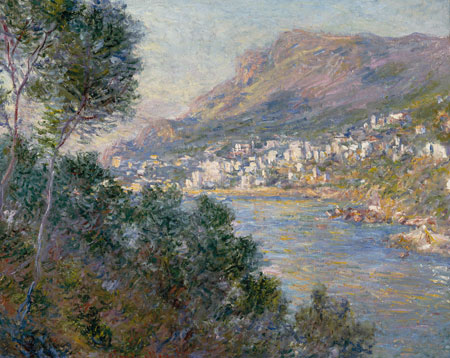
Claude Monet (French, 1840-1926): Monte Carlo seen from Roquebrune, 1884, oil on canvas, Scott M. Black Collection, photo by Benjamin Magro, courtesy, Portland Museum of Art, Maine, courtesy, Museum of Fine Arts, Boston.
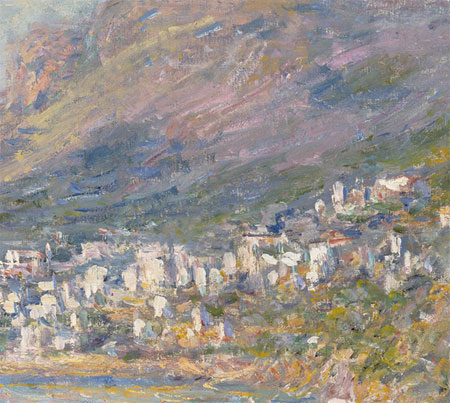
detail
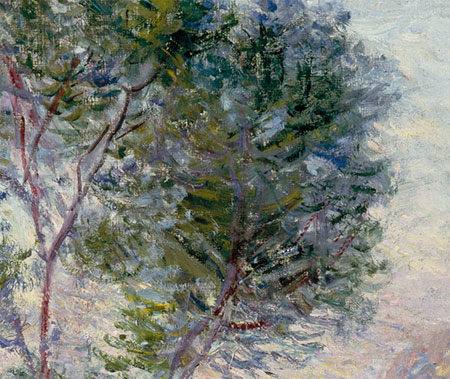
detail
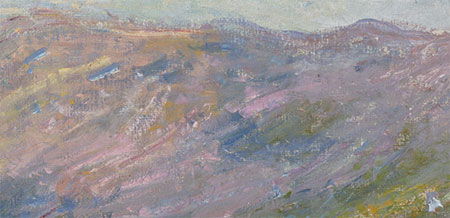
detail
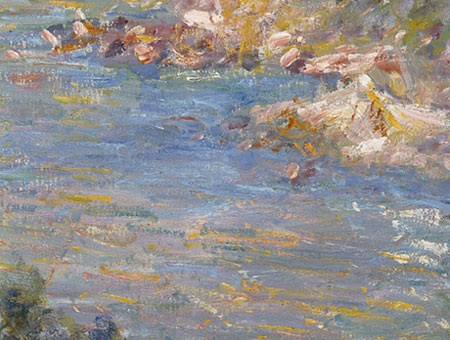
detail
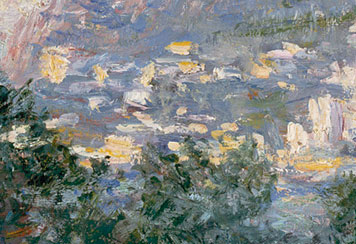
detail
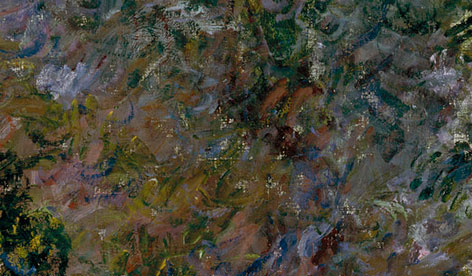
detail
2.
March 20, 2007, 1:30 PM
It may be that these Riviera views are already so picture-postcard perfect in reality that painting them is sort of like gilding the lily. The result is, or can be, a surfeit of pretty picturesqueness, and thus a bit cloying.
3.
March 20, 2007, 2:09 PM
I saw the Chicago exhibit, too! I think those were the most crowded galleries I've ever been in. I had only moved to town the day before, so I had no idea the show was even happening. A friend who already lived in Chicago dropped by and asked if I wanted to go (he had tickets as an AIC member.) Getting through the first couple of rooms was so exhausting, I was stunned to realize that they were only the very beginning.
Anyway, I tend to agree with opie regarding Monet's paintings done in the south of France.
4.
March 20, 2007, 6:55 PM
So I looked carefully at the picture, thinking: when you get close up, like the second detail (the tree) or the next-to-last detail (part of the city) you really see his genius at work. Then I read the comments, and there they were: my thoughts already typed out for me to read to myself.
5.
March 20, 2007, 7:06 PM
In concurrence with opie... "he could make a pale, virtually colorless scene sing coloristically." I have been slayed repeatedly by this. I brave Monet for having turned up my amplification many times to bury my head into a white noise that has never been grey. In these instances he has been the exquisite tape hiss that I have longed for sonically but could only have visually.
6.
March 20, 2007, 7:45 PM
Seems like we got ESP (Edmonton Sensory Perception) going on, Ahab. It used to be that Marc and I would enter the same comment on the same page at the same time, but that hasn't happened so much lately.
Great Minds, etc etc.
7.
March 20, 2007, 11:43 PM
Happens all the time, opie, but I usually just hold my tongue. It's when I disagree that I can't seem to bite it hard enough to shut up.
8.
March 21, 2007, 6:45 AM
... Monet had a limited audience, Now he adorns neck ties, garbage cans and coffee cups for baby boomers. His stuff is fuzzy cotton candy fluff to those who have spent half of their lives in front of an interactive virtual world; one based less on consumption of matterials than on mental processes and outcomes.
What information Monet's work provides is relevant only to some nostalgic painters, and those that actually look at the paintings that they have bought and own (and want to re-sell again of course.)
Monet will be valid again later on as far as I have been taught - when some rich people decide that it is time...
What seems to be of more importance is the vast amount of dolfins that are dead on the Texas coast - a greater number than ever. Maybe some of the manefestoes created in the past are more valid now than ever.
Perhapes lets toss Monet away for a bit, see what happens, and then bring-em back later when he is needed.
For now, his fluff is good for the church-of-the commodity, the chappell consumption, and the synagogue of the slippery slope.
9.
March 21, 2007, 8:45 AM
In the end, no matter what...Monet wins in the long run.
I agree, let's start a REVOLUTION!
10.
March 21, 2007, 9:22 AM
Perhapes lets toss Monet away for a bit, see what happens, and then bring-em back later when he is needed.
He is needed now. If you want to see a real Church of Commodity, you should drop by this thing one day.
11.
March 21, 2007, 11:12 AM
"Monet will be valid again later on as far as I have been taught"
I indeed believe this is as far as back-in-the-day has been taught.
But you will have to excuse me. I've got to go sell my Monet.
12.
March 21, 2007, 1:43 PM
Confession time: for me, Monet has largely been ruined by his reputation, at least amongst a certain tranche of the art-admiring classes here, as one of the last easy-on-the-eye, decorative Great Painters who flourished before All That Modern Rubbish.
It is telling that JL mentions crowds in the context of Monet. Sadly, though, I have a real problem thinking about Monet without those crowds getting in my way, figuratively as well as literally. The last time I found myself surrounded by them, I was almost panting for a good Kirchner or Dix or even Grunwald. Please, bring me some rebarbative ugliness, right now!
Having said that, I found the details that Franklin picked out - and that Opie praised - absolutely fascinating. Isolated, they were really beautiful, really compelling. So perhaps the way back to Monet lies through the "Abstract Impressionism" route? Never mind - I never "got" Titian's astounding late-ish gestural style until I managed to find a path to it through Frank Auerbach's better paintings. Verily, if one hangs around long enough there is hope for (virtually) all of us.
13.
March 21, 2007, 3:01 PM
Well, I don't mind being one of the crowd. Not if I am looking the last easy-on-the-eye, decorative Great Painter.
14.
March 21, 2007, 3:37 PM
Its funny how "uncool" it is to appreciate, like, or even admire a painter like Monet...meanwhile some overrated video conceptual installation blah blah, is regarded as some insightful artwork to save all artworks when in reality its a poor excuse for cinematography or short film, ...what’s wrong with appreciating a Monet? he's certainly more interesting and lasting than some of those paintings resembling Gap ads discussed recently on this blog... is it that many others regard them as masterpieces? Or that they are popular? Talk about bitterness, Just because many many people think something is great therefore mainstream, it automatically sucks to the "cool" kids...lol, keep cutting yourselves maybe then you'll be happy.
15.
March 21, 2007, 4:00 PM
Drew, all I am trying to say is that a lot of people really like Monet - because they see the evident beauty and calm in his work as a sort of riposte to the 'modern' art they hate, which sometimes looks troubled, messy or even ugly.
To some extent, that attitude has made me dislike Monet's work. What am I supposed to do, then? Would it be better to lie about how I was feeling, just to fit in? As I wrote, if you bother to read my actual post, I hope in due course to like these works more than I do now, through concentrating on details of the sort pointed out, implicitly or explicitly, by Franklin and Opie. But in any event, what I was trying to do was to express a genuine response to the paintings in question. You, obviously, regard this perspective as 'bitter'.
Meanwhile, being identified with 'cool kids' provokes a sort of colocynthic hilarity hereabouts, if only because I am a 41-year old stay-at-home mother who only gets out to exhibitions if they fit in with her toddler son's overwhelming priorities. Thanks so very much for your generous and sympathetic advice, but I don't think I'll keep 'cutting myself', as you put it. Actually, I think I'll keep looking at pictures, as and when I get a chance, and being honest about how I feel when I see them.
Whereas, Opie, your post made me sad. The people I am trying to describe thing Pollock's paintings can be counterfeited by clever baboons, or that industrial accidents produce 'art' as good as de Kooning. Sorry, but even standing in that sort of crowd is a sort of contamination. What they love about Monet is the absence from his work of pretty much everything that ever seems important to me in pictures. One is left with pastel colours, a lack of unpleasantness, a sort of misty non-engagement. Time, one suspects, to head for the exit.
16.
March 21, 2007, 4:43 PM
But Bunny, the pictures are not to blame for the people who don't get them. I know those who line up to admire Monet are exactly the same as those who laughed at and rejected his pictures 100+ years ago. What do you expect? They only bother me when there are so many of them it is hard to see the paintings.
And as for "what's important in pictures", there is only one thing that is important. It has to be a good picture.
17.
March 21, 2007, 4:48 PM
Part of the problem, of course, is the uncontrolled, endless, painfully thoughtless and even more painfully crass hyper-commercialization of Impressionist art in general, often by museum people who should know better (i.e., the gift shop syndrome). The trivialization of Monet, Van Gogh et al. via countless silly trinkets, each more dubious and tacky than the next, can only be justified on the basis of turning a profit (for those who think that way). Then there's the "blockbuster show" syndrome, which is also money-driven and similarly ill-judged, as well as ultimately vulgar (a glorified P.T. Barnum ploy, when you think of it). Sigh.
18.
March 21, 2007, 5:04 PM
41 istnt very old bunny , and both you and your children are very lucky to have you be a stay at home mom,( no sarcasm or disrespect intended ) but its true, if its good its good, and nice or whateverelse, and i guess your comments except maybe the open mindedness to someday hope to like the paintings are somewhat coolkidish, its very "cool" to dislike or disaprove of anyone in an art history book with a pretty picture or mass appeal.
19.
March 21, 2007, 5:35 PM
very true jack, and bunny i ment not old at all...
20.
March 21, 2007, 6:59 PM
Currently even the best Impressionist works seem to suffer from a heavy case of Forgettablism - oddly ironic, that.
21.
March 21, 2007, 7:43 PM
Pollock and Smith are as easy on my eye as Monet.
22.
March 27, 2007, 5:54 PM
Sometimes it's nice viewing these by starting with the Detail first and working your way up to the finished piece. It's like watching a great movie and wondering how it's all going to end.
1.
opie
March 20, 2007, 1:18 PM
Monet is a favorite paintier, but his Riviera paintings have never been at the top of my list. He was a great colorist but he sometimes had difficulty when there was too much color in the motif, or, perhaps more accurately, when the light was intense, saturating and "warm". On the other hand he could make a pale, virtually colorless scene sing coloristically (The Magpie, 1868). And then, on the other hand again, he could wrestle a masterpeice from a simple haystack with the sun behind it which is nothing but hot color (Haystack at Sunset 1891). Go figure, as they say.
However, I think (or feel) that the hot sun and humid atmosphere of the Rivera led him to "melt" his surfaces. These pictures are made up of very small strokes (also a big problem for Pissarro in the late 1800s) and more often than not taken from great distances from an elevation, and they lack the clean sharp authority of his best paintings. His pictures always seem best when the subject makes it easy for his paint strokes to show as such.
But then when you get close up, like the second detail (the tree) or the next-to-last detail (part of the city) you really see his genius at work, pure "Abstract Impressionism" at its best.